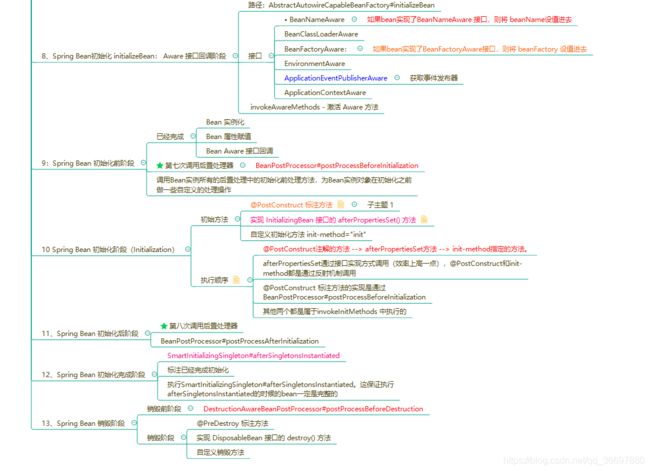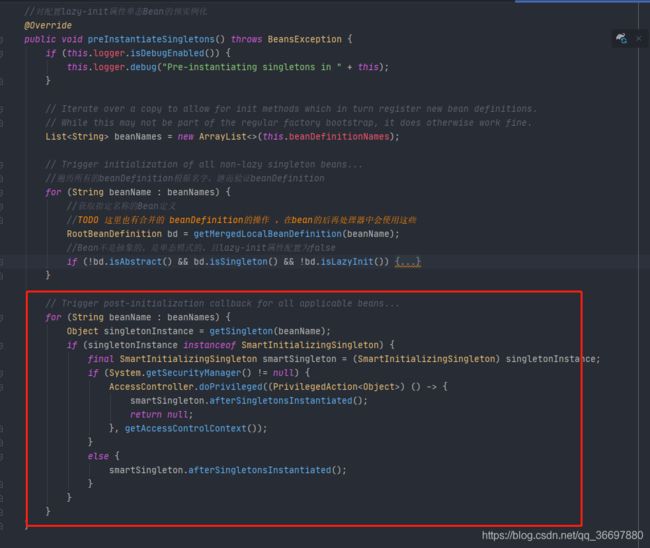spring bean生命周期四---Spring Bean 初始化阶段(Initialization)
目录
概述
一、initializeBean
2.1、invokeAwareMethods - 激活 Aware 方法
2.2、Spring Bean 初始化前阶段
第七次调用后置处理器
2.3、 invokeInitMethods - 激活自定义的init方法
2.4、Spring Bean 初始化后阶段
第八次调用后置处理器 postProcessAfterInitialization
三、Spring Bean 初始化完成阶段
四、测试代码案例:
概述
本文是笔者阅读Spring源码的记录文章,由于本人技术水平有限,在文章中难免出现错误,如有发现,感谢各位指正。在阅读过程中也创建了一些衍生文章,衍生文章的意义是因为自己在看源码的过程中,部分知识点并不了解或者对某些知识点产生了兴趣,所以为了更好的阅读源码,所以开设了衍生篇的文章来更好的对这些知识点进行进一步的学习。
这篇文章是 spring bean生命周期二---Spring Bean实例化( Instantiation)阶段 的文章的展开内容。Spring 在 AbstractAutowireCapableBeanFactory#doCreateBean 方法中,完成了bean的完整创建。而在上篇 spring bean生命周期三---Spring Bean populateBean 属性填充阶段 中,完成了Bean的属性注入,表面上看起来 Bean的创建过程已经结束了。实际上还有一些收尾工作没有完成。本文就是完成Bean创建的收尾工作:完成 Aware 接口的功能,调用后处理器的Bean的后置方法,以及指定的init 方法的激活。
本阶段主要包括:激活 Aware 方法、Spring Bean 初始化前阶段、Spring Bean 初始化阶段(Initialization)、Spring Bean 初始化后阶段、Spring Bean 初始化完成阶段。
一、initializeBean初始化阶段
相较于前几篇的内容,本文的内容显得简单了很多。具体代码如下:
下面的代码只要完成了 Spring Bean 初始化前阶段、Spring Bean 初始化阶段(Initialization)、Spring Bean 初始化后阶段
//初始容器创建的Bean实例对象,为其添加BeanPostProcessor后置处理器
protected Object initializeBean(final String beanName, final Object bean, @Nullable RootBeanDefinition mbd) {
//JDK的安全机制验证权限
if (System.getSecurityManager() != null) {
//实现PrivilegedAction接口的匿名内部类
AccessController.doPrivileged((PrivilegedAction2.1、invokeAwareMethods - 激活 Aware 方法
这个方法很简单,完成了 Aware 接口的激活功能。可以简单的说 :
- 如果bean实现了
BeanNameAware接口,则将 beanName设值进去 - 如果bean实现了
BeanClassLoaderAware接口,则将 ClassLoader 设值进去 - 如果bean实现了
BeanFactoryAware接口,则将 beanFactory 设值进去
private void invokeAwareMethods(final String beanName, final Object bean) {
if (bean instanceof Aware) {
if (bean instanceof BeanNameAware) {
((BeanNameAware) bean).setBeanName(beanName);
}
if (bean instanceof BeanClassLoaderAware) {
ClassLoader bcl = getBeanClassLoader();
if (bcl != null) {
((BeanClassLoaderAware) bean).setBeanClassLoader(bcl);
}
}
if (bean instanceof BeanFactoryAware) {
((BeanFactoryAware) bean).setBeanFactory(AbstractAutowireCapableBeanFactory.this);
}
}
}这里简单解释一下 Aware的作用。从上面的代码可以看到,实现不同类型的 Aware 接口会接受到不同得到初始化数据。
举个例子: 如果bean实现了 BeanFactoryAware 接口,那么他就可以在bean内部获取到beanFacotory。
其实Aware 接口的作用 我在分析 AutowiredAnnotationBeanPostProcessor 后处理器的时候才突然想明白的。 AutowiredAnnotationBeanPostProcessor 中完成了Bean的属性和方法注入,属性要从BeanFactory 的缓存中获取,那么AutowiredAnnotationBeanPostProcessor 如何得到的beanFactory呢? 答案是实现了BeanFactoryAware 接口。这样在 AutowiredAnnotationBeanPostProcessor 初始化的时候就通过void setBeanFactory(BeanFactory beanFactory) 获取到beanFactory。如下图。AutowiredAnnotationBeanPostProcessor 保存了setBeanFactory 带来的beanFactory,并通过此来从容器中获取需要的bean。![]()
2.2、Spring Bean 初始化前阶段
这里只要是使用加载处理: BeanPostProcessor#postProcessAfterInitialization的实现类
//todo 第七次调用后置处理器 BeanPostProcessor后置处理器的postProcessBeforeInitialization
//回调方法的调用,为Bean实例初始化前做一些处理
if (mbd == null || !mbd.isSynthetic()) {
wrappedBean = applyBeanPostProcessorsBeforeInitialization(wrappedBean, beanName);
}
第七次调用后置处理器
@Override
//调用BeanPostProcessor后置处理器实例对象初始化之前的处理方法
public Object applyBeanPostProcessorsBeforeInitialization(Object existingBean, String beanName)
throws BeansException {
Object result = existingBean;
//遍历容器为所创建的Bean添加的所有BeanPostProcessor后置处理器
for (BeanPostProcessor beanProcessor : getBeanPostProcessors()) {
//调用Bean实例所有的后置处理中的初始化前处理方法,为Bean实例对象在初始化之前做一些自定义的处理操作
//
Object current = beanProcessor.postProcessBeforeInitialization(result, beanName);
if (current == null) {
return result;
}
result = current;
}
return result;
}2.3、 invokeInitMethods - 激活自定义的init方法
首先需要注意的是,Bean 的初始化方法除了可以使用
init-method属性(或者@Bean(initMethod=''”)),还可以通过实现InitializingBean接口,并且在afterPropertiesSet方法中实现自己初始化的业务逻辑。
调用顺序则是 afterPropertiesSet 先调用,后面调用 init-method 指定的方法。这一点从下面的代码逻辑就能看到。
protected void invokeInitMethods(String beanName, final Object bean, @Nullable RootBeanDefinition mbd)
throws Throwable {
// 首先检查是否是InitializingBean,如果是的话则需要调用 afterPropertiesSet 方法。
boolean isInitializingBean = (bean instanceof InitializingBean);
if (isInitializingBean && (mbd == null || !mbd.isExternallyManagedInitMethod("afterPropertiesSet"))) {
if (logger.isTraceEnabled()) {
logger.trace("Invoking afterPropertiesSet() on bean with name '" + beanName + "'");
}
// 调用 afterPropertiesSet 方法
if (System.getSecurityManager() != null) {
try {
AccessController.doPrivileged((PrivilegedExceptionAction2.4、Spring Bean 初始化后阶段
这里只要是使用加载处理: BeanPostProcessor#postProcessAfterInitialization 的实现类
//todo 第八次调用 BeanPostProcessor后置处理器的postProcessAfterInitialization
//回调方法的调用,为Bean实例初始化之后做一些处理
if (mbd == null || !mbd.isSynthetic()) {
wrappedBean = applyBeanPostProcessorsAfterInitialization(wrappedBean, beanName);
}第八次调用后置处理器 postProcessAfterInitialization
@Override
//调用BeanPostProcessor后置处理器实例对象初始化之后的处理方法
public Object applyBeanPostProcessorsAfterInitialization(Object existingBean, String beanName)
throws BeansException {
Object result = existingBean;
//TODO 遍历容器为所创建的Bean添加的所有BeanPostProcessor后置处理器
for (BeanPostProcessor beanProcessor : getBeanPostProcessors()) {
//调用Bean实例所有的后置处理中的初始化后处理方法,为Bean实例对象在
//初始化之后做一些自定义的处理操作
Object current = beanProcessor.postProcessAfterInitialization(result, beanName);
if (current == null) {
return result;
}
result = current;
}
return result;
}三、Spring Bean 初始化完成阶段
主要是回调:SmartInitializingSingleton#afterSingletonsInstantiated
使用场景:实现SmartInitializingSingleton的接口后,当所有单例 bean 都初始化完成以后, Spring的IOC容器会回调该接口的 afterSingletonsInstantiated()方法。
主要应用场合就是在所有单例 bean 创建完成之后,可以在该回调中做一些事情,例如:
import org.springframework.beans.factory.ListableBeanFactory;
import org.springframework.beans.factory.SmartInitializingSingleton;
import org.springframework.stereotype.Component;
@Component
public class MyRegister implements SmartInitializingSingleton {
private ListableBeanFactory beanFactory;
public MyRegister(ListableBeanFactory beanFactory) {
this.beanFactory = beanFactory;
}
@Override
public void afterSingletonsInstantiated() {
String[] beanNames = beanFactory.getBeanNamesForType(IPerson.class);
for (String s : beanNames) {
System.out.println(s);
}
}
}在Spring容器启动时,通过SpringApplication.run()-->SpringApplication.refreshContext()-->SpringApplication.refresh() -->AbstractApplicationContext.refresh(),在这个refresh()函数过程中会调用 finishBeanFactoryInitialization(beanFactory)来提前初始化单例bean,具体方法是调用beanFactory.preInstantiateSingletons(),而这里的beanFactory实例实际为接口 ConfigurableListableBeanFactory 的实现类DefaultListableBeanFactory的实例对象。
查看到DefaultListableBeanFactory.preInstantiateSingletons()的源码如下:
至此 bean对象完成被创建成功。
四、测试代码案例:
下面是创建 UserHolder 初始化已经销毁过程
public class UserHolder implements BeanNameAware, BeanClassLoaderAware, BeanFactoryAware, EnvironmentAware,
InitializingBean, SmartInitializingSingleton, DisposableBean {
private final User user;
private Integer number;
private String description;
private ClassLoader classLoader;
private BeanFactory beanFactory;
private String beanName;
private Environment environment;
public UserHolder(User user) {
this.user = user;
}
public Integer getNumber() {
return number;
}
public void setNumber(Integer number) {
this.number = number;
}
public String getDescription() {
return description;
}
public void setDescription(String description) {
this.description = description;
}
/***** 下面是 Aware 回调方法*** */
@Override
public void setBeanClassLoader(ClassLoader classLoader) {
this.classLoader = classLoader;
}
@Override
public void setBeanFactory(BeanFactory beanFactory) throws BeansException {
this.beanFactory = beanFactory;
}
@Override
public void setBeanName(String name) {
this.beanName = name;
}
@Override
public void setEnvironment(Environment environment) {
this.environment = environment;
}
/***** =Aware 回调方法 结束*** */
/**
* 依赖于注解驱动
* 当前场景:BeanFactory
*/
@PostConstruct
public void initPostConstruct() {
// postProcessBeforeInitialization V3 -> initPostConstruct V4
this.description = "The user holder V4";
System.out.println("initPostConstruct() = " + description);
}
/**
* InitializingBean 的初始化话方法
* @throws Exception
*/
@Override
public void afterPropertiesSet() throws Exception {
// initPostConstruct V4 -> afterPropertiesSet V5
this.description = "The user holder V5";
System.out.println("afterPropertiesSet() = " + description);
}
/**
* 自定义初始化方法
*/
public void init() {
// initPostConstruct V5 -> afterPropertiesSet V6
this.description = "The user holder V6";
System.out.println("init() = " + description);
}
/**
* 注解中的销毁方法
*/
@PreDestroy
public void preDestroy() {
// postProcessBeforeDestruction : The user holder V9
this.description = "The user holder V10";
System.out.println("preDestroy() = " + description);
}
/**
* DisposableBean的销毁方法
*/
@Override
public void destroy() throws Exception {
// preDestroy : The user holder V10
this.description = "The user holder V11";
System.out.println("destroy() = " + description);
}
/**
* 自定义销毁方法
*/
public void doDestroy() {
// destroy : The user holder V11
this.description = "The user holder V12";
System.out.println("doDestroy() = " + description);
}
@Override
public void afterSingletonsInstantiated() {
// postProcessAfterInitialization V7 -> afterSingletonsInstantiated V8
this.description = "The user holder V8";
System.out.println("afterSingletonsInstantiated() = " + description);
}
protected void finalize() throws Throwable {
System.out.println("The UserHolder is finalized...");
}
@Override
public String toString() {
return "UserHolder{" +
"user=" + user +
", number=" + number +
", description='" + description + '\'' +
", beanName='" + beanName + '\'' +
'}';
}
}InstantiationAwareBeanPostProcessor的自定义实现:
class MyInstantiationAwareBeanPostProcessor implements InstantiationAwareBeanPostProcessor {
@Override
public Object postProcessBeforeInstantiation(Class beanClass, String beanName) throws BeansException {
if (ObjectUtils.nullSafeEquals("superUser", beanName) && SuperUser.class.equals(beanClass)) {
// 把配置完成 superUser Bean 覆盖
return new SuperUser();
}
return null; // 保持 Spring IoC 容器的实例化操作
}
@Override
public boolean postProcessAfterInstantiation(Object bean, String beanName) throws BeansException {
if (ObjectUtils.nullSafeEquals("user", beanName) && User.class.equals(bean.getClass())) {
User user = (User) bean;
user.setId(2L);
user.setName("mercyblitz");
// "user" 对象不允许属性赋值(填入)(配置元信息 -> 属性值)
return false;
}
return true;
}
// user 是跳过 Bean 属性赋值(填入)
// superUser 也是完全跳过 Bean 实例化(Bean 属性赋值(填入))
// userHolder
@Override
public PropertyValues postProcessProperties(PropertyValues pvs, Object bean, String beanName)
throws BeansException {
// 对 "userHolder" Bean 进行拦截
if (ObjectUtils.nullSafeEquals("userHolder", beanName) && UserHolder.class.equals(bean.getClass())) {
// 假设

